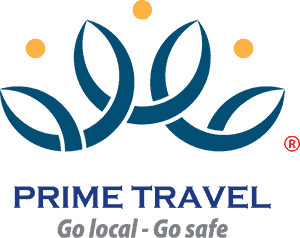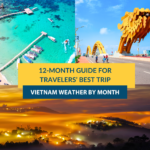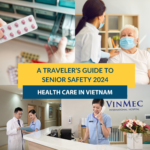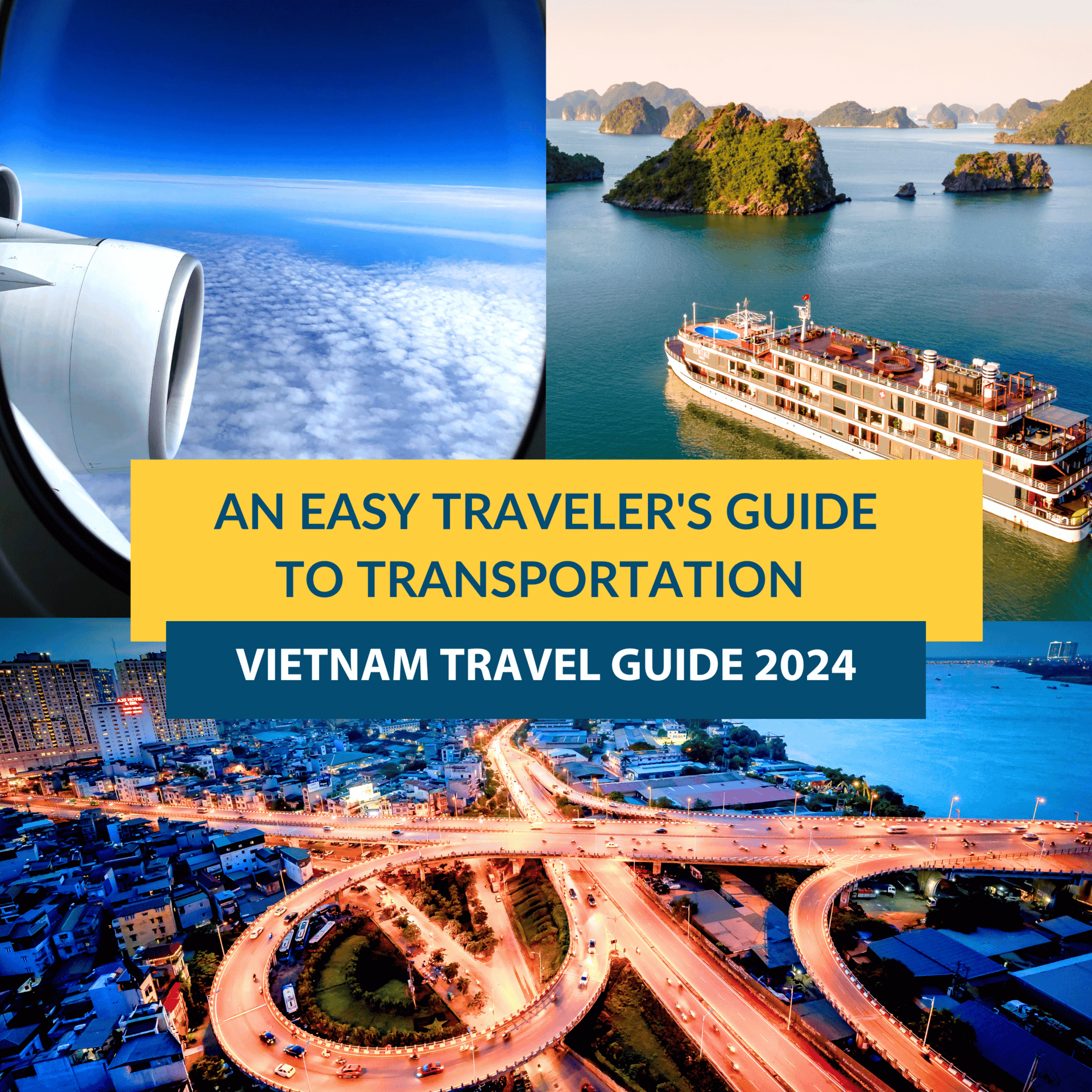
How to Travel in Vietnam: An Easy Guide to Transportation for Travelers 2025
Vietnam, with its diverse landscapes, bustling cities, and serene countryside, offers countless travel experiences. Understanding how to travel in Vietnam is essential, as the country’s transportation system varies greatly between urban centers and rural areas. Whether you’re planning to explore by air, land, or water, knowing your options can help you avoid common pitfalls and make your journey smoother.
This comprehensive guide to transportation in Vietnam provides everything you need to know. It also introduces the services offered by Prime Travel, ensuring comfort and reliability in what can sometimes be a chaotic system.
Overview of Transportation in Vietnam
Transportation in Vietnam spans a wide range of options, catering to both short and long-distance travel. The country’s transportation network primarily runs along a North-South axis, with key highways, railways, and air routes connecting major cities and provinces.
The main road network consists of national highways and expressways, linking regions within Vietnam and extending to international borders with China, Laos, and Cambodia. Motorbikes and scooters remain the most popular means of transport for locals, especially for short distances. This is due to their affordability, flexibility, and ability to navigate congested streets.
In major cities like Hanoi and Ho Chi Minh City, there are a variety of transportation options available, so locals and visitors alike can easily choose from ride-hailing apps, public buses, or other modes of travel to quickly access most areas. However, in more remote regions, travel can be more challenging, especially on older roads or in rural areas.
For travelers, understanding the various transportation options available in the areas you plan to visit, and how they work together, is essential for knowing how to travel in Vietnam efficiently.
Read more>>> Got Questions about Travelling in Vietnam?
Types of Transportation in Vietnam
By Air
Airplane
Air travel is the fastest and most convenient option for covering both long domestic routes and international travel to Vietnam. The country has 10 international airports, including major hubs like Noi Bai International Airport (Hanoi), Tan Son Nhat International Airport (Ho Chi Minh City), and Da Nang International Airport. These airports connect Vietnam to destinations across Asia, Europe, and the Americas.
Visitors from regions like Europe or North America may need to transit through major hubs in Asia, such as Singapore, Bangkok, or Hong Kong, as direct flights to Vietnam are limited to specific cities. However, travelers from neighboring countries in Southeast Asia and parts of East Asia often have direct flight options.
Vietnam has a total of 22 airports, serving key cities and provinces nationwide. Domestic airlines, such as Vietnam Airlines, VietJet Air, and Bamboo Airways, operate an extensive network with 49 domestic routes, ensuring connectivity across the country. Ticket prices vary, with budget carriers offering competitive rates, especially during promotional periods, while Vietnam Airlines and Bamboo Airways provide more premium services at higher costs.
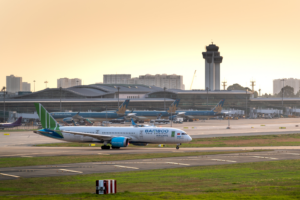
How to travel to Vietnam: International airports in Vietnam (Source: Internet)
In addition to these major carriers, Pacific Airlines and Vietravel Airlines also serve the domestic market with cheaper fares, but they have fewer flights and simpler services.
Domestic flights are often the best option for saving time on long routes like from the south to north or north to central. While air travel is generally reliable, delays are not uncommon, particularly with budget airlines.
Seaplane
Seaplane services in Vietnam, provided exclusively by Hai Au Aviation, offer a unique travel experience for those looking to explore the country from the sky. The seaplanes typically carry up to 12 passengers and offer three types of services: scheduled flights, scenic flights, and chartered flights.
Scheduled flights connect popular destinations like Hue to Quang Binh, Ha Long to Co To, and Da Nang to Dong Hoi. Scenic flights, available in Ha Long and Hue, allow travelers to enjoy breathtaking aerial views of Vietnam’s coastline and landscapes, making for a truly memorable experience.
For a more personalized journey, chartered flights can be arranged, allowing customers to choose their own route and travel schedule. This mode of transportation in Vietnam is perfect for those seeking a quick, efficient, and adventurous way from above.
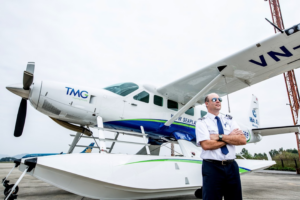
Transportation in Vietnam: Hai Au Aviatation
Read more>>> HANOI – LAN HA BAY WITH SEAPLANE 2 DAYS
By Land
Trains
Traveling by train in Vietnam is a relaxing and scenic option, perfect for those who enjoy taking in the country’s diverse landscapes at a slower pace. The North-South railway, stretching 2,600 kilometers, connects Hanoi and Ho Chi Minh City. This journey is often regarded as one of the most picturesque train routes in Southeast Asia, offering breathtaking views of mountains, coastal lines, and rural villages.
Trains in Vietnam generally operate at a slower speed compared to buses or flights, so travelers should plan accordingly, especially for long-distance routes. The comfort, safety and cultural experience, however, often make the slower pace worthwhile.
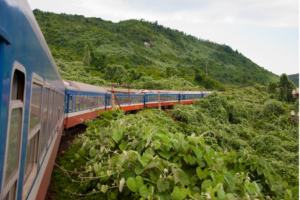
Transportation in Vietnam: Train travel in Vietnam (Source: Internet)
There are four main seat classes available: hard seats, soft seats, hard sleeper berths, and soft sleeper berths. Not all trains offer every class, so it’s important to check in advance when booking tickets. For example, overnight trains typically provide sleeper berths, while shorter daytime routes may focus on seated options. The Vietnam Railway Corporation operates the majority of trains, but several private companies, such as Livitrans Express and Violette Train, offer upgraded cabins with enhanced comfort for tourists.
Train ticket prices vary depending on the route, class, and operator. Tickets can be booked online, at railway stations, or through travel agents. For popular routes or during holiday seasons, early booking is highly recommended.
Limousine Vans
Limousine vans provide a premium travel experience, catering to small groups or individuals who desire more comfort and privacy compared to standard buses. These vehicles come in various sizes, typically with seating capacities of 9, 11, 17, 19 seats, offering a higher level of comfort than regular seating buses. Inside, the seats are padded and designed for a more relaxing ride, and each limo is equipped with charging ports.
These services are popular for medium-range routes, typically under 300 kilometers, as they offer a faster and more reliable option than traditional buses. This type of transportation is especially suited for groups or travelers who value convenience and a higher level of service.
However, limousine vans do not have dedicated luggage compartments. If you have luggage, it will need to be stored under the seats, which may not be ideal for large or bulky items. Therefore, these vans are well-suited for day tours where travelers do not need to bring a lot of luggage with them.
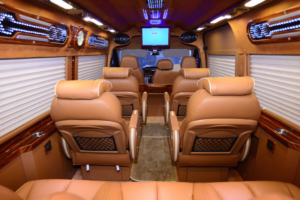
Transportation in Vietnam: 9-Seat Limousine (Source: Internet)
Sleeper Buses
Sleeper buses are a practical and budget-friendly option for travelers covering long distances in Vietnam. They offer a faster alternative to trains and are significantly cheaper than flights, without the hassle of airport procedures.
Commonly used for routes exceeding 100 km, such as Hanoi to Sapa or Ho Chi Minh City to Dalat, sleeper buses cater to both locals and tourists looking for convenience and affordability. These buses typically come in two types: standard and premium, offering options to suit different budgets and comfort levels.
- Standard Sleeper Buses
Standard sleeper buses typically have 32, 34, or 44 beds arranged in three rows and two levels, with each seat functioning as a bed for one passenger. Each passenger has an individual bed space, though the size is more suitable for those under 180 cm tall.
Basic amenities include a blanket and pillow, as well as complimentary bottled water. The ticket price varies depending on the destination, duration, and trip length.
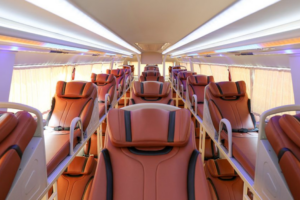
Transportation in Vietnam: Standard Sleeper Bus (Source: Internet)
- Premium Sleeper Buses
For a more luxurious experience, premium cabin buses are an excellent choice. These buses typically have 22 private cabins arranged in two rows and two levels, offering extra space and enhanced privacy. The buses offer both single and double cabins, designed for couples or solo travelers.
The cabins are spacious enough for two adults under 170 cm tall and feature luxurious amenities such as LCD screens for entertainment, charging ports for devices, and adjustable lighting and ventilation.
Some operators even provide onboard restrooms, elevating the level of comfort. The ticket price depends on the route and duration.
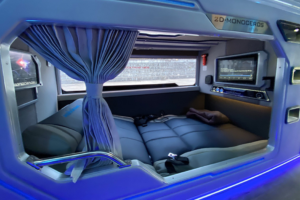
Transportation in Vietnam: Premium Sleeper Bus (Source: Internet)
Seated Buses
For shorter distances under 100 km, seated buses are a popular choice, especially for group travel. These buses come in various sizes, including 16-seat, 29-seat, and 45-seat configurations, each serving different purposes:
- 16-seat buses are ideal for smaller groups. However, the luggage compartment is limited to the rear of the bus. If you have a lot of luggage, you may need to fold the last 4 seats to make room. It’s important to keep this in mind when booking a 16-seat bus for larger luggage.
- 29-seat and 45-seat buses are more spacious and typically used for larger groups. These buses have wider luggage compartments located along the sides, providing ample space for bags and equipment.
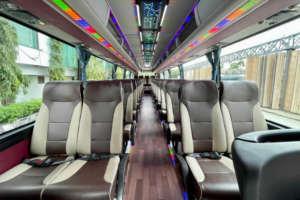
Transportation in Vietnam: 45 Seated Buses (Source: Internet)
Local Public Bus
For traveling within cities like Hanoi or Ho Chi Minh City, local city buses are an affordable option. The fare typically ranges from VND 8,000 to 20,000 per trip, depending on the route and distance. If you’re planning to use this mode of transport for exploring the city, it’s important to research the bus routes and stops in advance (e.g., Bus No. 21 in Hanoi, which covers key areas).
However, city buses can be crowded, and navigating the bus system might be tricky for first-time visitors. It’s also important to know how to catch the bus at designated stops. For convenience and safety, especially during busy times, taxis or app-based ride-hailing services are a more comfortable and reliable alternative.
Read more>>> Sapa Guide and Itinerary: Best Things to Do for Travelers 2024
Taxis and Ride-hailing Apps
Taxis are a convenient option for getting around Vietnam’s cities, but it’s important to be cautious to avoid potential scams.
There are two main types of taxis: 4-seat and 7-seat vehicles, each suited to different travel needs.
- 4-seat taxis are ideal for solo travelers or small groups. They are easy to find, making them great for navigating busy urban areas. However, for a group of four adults, the space can feel cramped, and there’s limited room for luggage.
- 7-seat taxis are better for larger groups or families, offering more space and comfort with ample luggage storage. However, these vehicles can struggle to navigate narrow streets, particularly in crowded city centers.
In Vietnam, trusted taxi companies like Mai Linh, G7, Taxi Group and Vinasun operate with a starting fare around 14,000 VND/km. It’s important to avoid unmarked taxis, as they often inflate prices or attempt to scam passengers. Always look for well-known brands or reputable services.
If you prefer more control over your ride, ride-hailing apps like Grab, and Be are reliable alternatives. These apps let you choose your route, vehicle type, and even see the fare upfront, ensuring a fair and transparent price. Whether you opt for a traditional taxi or use a ride-hailing app, both offer convenient ways to get around Vietnam with ease.

Transportation in Vietnam: Xanh SM Technology Cars (Source: Internet)
Motorbikes
Motorbikes are a popular and practical option for short trips or those seeking a more adventurous way to explore the city and surrounding areas. They’re ideal for navigating through narrow streets or traffic jams, making them perfect for quick errands or sightseeing.
In Vietnam, motorbikes are commonly available as “xe om” (motorbike taxis), or through ride-hailing apps like Grab. However, if you’re hailing a “xe om” directly from the street, be cautious as some drivers may overcharge or scam passengers. To ensure fair pricing and safety, it’s better to use apps like Grab or Be, which also offer motorbike options in addition to cars.
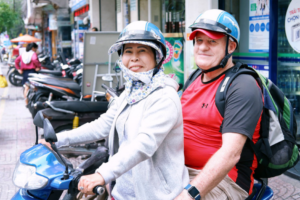
Transportation in Vietnam: Motorbike Taxis (Source: Internet)
For a more immersive experience, visitors can rent a motorbike or join a guided motorbike tour. This is a great way to experience the vibrant streets of Vietnam up close, especially for those who enjoy adventure and want to blend in with the local lifestyle. Renting a motorbike requires an international driver’s license, and it’s essential to wear a helmet and follow safety rules, as traffic in Vietnam can be chaotic.
Whether you’re zipping through the city on a motorbike taxi or taking a leisurely ride through the streets, this mode of transportation offers a unique way to experience the energy and excitement of Vietnam.
Read more>>> Vietnam Travel Insurance: The best guide before you go
Cyclo, Jeep, and Two-decker Buses
In Vietnam, while there are various modes of transportation, there are still a few other transport options for exploring the cities or scenic landscapes that offer a unique experience. Here’s a breakdown of each one:
| Transport | Advantages | Disadvantages | Best For |
| Cyclo | – Slow and relaxed ride, perfect for sightseeing.
– Can access narrow streets. – Traditional, cultural experience. |
– Not suitable for long distances.
– Exposed to weather conditions. – Can be pricey if not negotiated well. |
– City exploration
– Short trips in urban areas like Hanoi or Ho Chi Minh City. |
| Jeep | – Great for off-road adventures.
– Spacious and comfortable for groups. – Fun and adventurous. |
– Limited availability in cities.
– Can be costly. – Not suitable for crowded streets. |
– City sightseeing with a touch of adventure
– Exploring beaches or natural landscapes like Mui Ne. |
| Two-decker Bus | – Comfortable, air-conditioned for city tours.
– Ideal for groups, family trips. – Provides panoramic views from the top deck. |
– Restricted to specific routes.
– Not suitable for narrow streets. – Can be crowded during peak tourist seasons. |
– City sightseeing
– Long-distance travel between major tourist spots. |
By water
Cruises
Cruises are a popular choice for those looking to experience Vietnam’s coastal beauty in a relaxed and leisurely manner. These cruises are typically available for both day trips and overnight journeys, offering a range of services to cater to different needs and budgets.
- Day cruise
There are various types of boats available for day cruises, ranging from smaller to larger vessels. However, most day cruises do not have private cabins. Instead, passengers typically share a common space, which could be used as a lounge area or a dining room, especially on boats designed for scenic sightseeing. These shared spaces are where guests can relax or enjoy meals while taking in the views. Day cruises are ideal for shorter excursions, where the focus is on enjoying the sights rather than extended comfort or privacy.
- Overnight Cruises
In contrast, overnight cruises offer private cabins, providing a more intimate and comfortable experience. These cruises allow guests to stay on the water for one or more nights, with a focus on relaxation and privacy. They often include additional services such as gourmet dining, special activities like Tai Chi or cooking classes, and access to more exclusive or secluded areas.
The cabins and facilities on overnight cruises are designed for comfort and luxury, with many boats offering premium amenities such as pool, jacuzzi, spas, and fitness centers.

Transportation in Vietnam: Cruise in Halong Bay (Source: Internet)
Read more>>> How to Choose the Best Halong Bay Cruise: 8-Step Guide for Your Perfect Trip
Speedboats
Speedboats are a fast and thrilling way to explore Vietnam’s coastline, offering an exciting and dynamic experience for those looking to cover more ground in a short amount of time. Smaller than cruise, these boats are designed for speed and efficiency, allowing travelers to reach less accessible beaches, hidden coves, or remote islands with ease. The sleek and streamlined design of speedboats ensures a smooth and exhilarating ride along the coast.
While they are compact, speedboats are equipped with basic amenities to ensure comfort during your journey. Some models also include small storage areas for water sports gear, like snorkeling equipment or small kayaks, allowing you to enjoy a variety of activities during your trip.
The design is focused on practicality, with ample open space for passengers to enjoy the scenic views, but without the extra luxuries of larger yachts or overnight cruises. Perfect for short trips or quick getaways, speedboats offer flexibility, adventure, and privacy, making them ideal for those seeking a more personalized and exciting experience on the water.
Ferries
Ferries are an essential part of Vietnam’s transport network, offering a reliable and affordable way to travel between the mainland and popular island destinations like Phu Quoc, Cat Ba, and others. These large, sturdy vessels are primarily designed to transport both passengers and vehicles.
Ferries typically take longer to reach their destinations, with journeys sometimes lasting between 1.5 to 2 hours or more, depending on the route. However, they are equipped with basic facilities like air-conditioned cabins, outdoor decks, and sometimes even cafeterias or refreshment stalls.
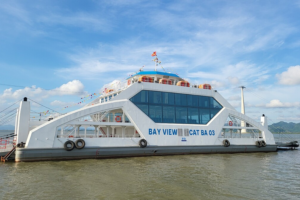
Transportation in Vietnam: Ferry to Cat Ba (Source: Internet)
Prime Travel: Premium Services for Seamless Transportation in Vietnam
When planning the trip, you may be confused about the choice between budget services and premium options. While budget services may seem appealing, they often lack the comforts and amenities that ensure a comfortable experience.
That’s where Prime Travel excels – offering a premium alternative for transportation in Vietnam that combines reliability, comfort, and quality. Our tailored services ensure smooth transfers between destinations and personalized experiences for tourists.
- For groups of 1-3 passengers, we offers 5-seat or 7-seat vehicles (depending on the amount of luggage)
- For 4-9 passengers, a 16-seat vehicle is provided
- For 10-15 passengers, a 29-seat vehicle is available
- For larger groups of 15-20 passengers, a 35-seat vehicle is used
- For 21-40 passengers, we provides a 45-seat vehicle
This system ensures that all passengers have comfortable seating and sufficient space for their luggage, eliminating any concerns about overcrowding or lack of storage.
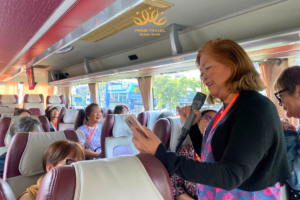
Guide to transportation in Vietnam: Getting around Vietnam (Source: Prime Travel)
Here are some vehicle models we commonly use, suited to different group sizes:
- 16-seat vehicles: Two types are available; Ford Transit and Hyundai Solati. The Ford Transit offers a slightly narrower interior, while the Hyundai Solati provides a more spacious and modern design, ensuring a comfortable and airy ride for passengers.
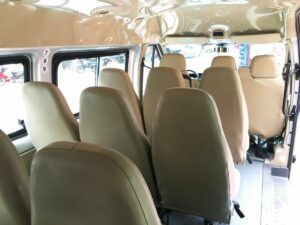
Guide to Transportation in Vietnam: Ford Transit 16-Seater Van (Source: Internet)
- 29-seat vehicles: Two options are available; Hyundai County and Thaco. The Hyundai County has an older design with a more compact space, smaller seats, and a rear luggage compartment that offers limited storage. The Thaco model, on the other hand, is more spacious, with a larger frame and two side luggage compartments for better storage capacity, providing ample space for both passengers and their belongings.
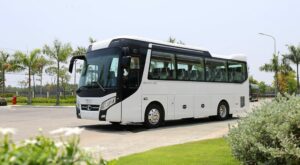
Guide to transportation in Vietnam: Thaco 29-seater bus in Vietnam (Source: Internet)
Read more>>> 5 Steps to find the best Vietnam tour operators for your trip
Essential Guide on How to Travel in Vietnam
How to Book
Online
For those wondering how to travel in Vietnam, booking transportation online has become an increasingly popular and convenient option. Some platforms like Baolau or 12Go Asia offer an easy way to compare schedules, prices, and routes. You can browse through customer reviews and get a clear idea of the service quality by checking out the operators’ ratings and comments on social media or travel forums.
Airlines also provide direct booking options via their websites, or you can use platforms like Skyscanner to find the best flight deals. Booking online not only saves time but also helps ensure that your trip runs smoothly, especially during peak seasons when transportation can be in high demand.
After Arrival
If you’ve already arrived in Vietnam and are unsure how to get around, the hotel staff can be your guide to transportation in Vietnam. They can help arrange your rides, whether it’s booking taxis, buses, or private cars, often at competitive prices. This method also adds a layer of convenience, as you don’t have to worry about language barriers or finding transportation yourself.
Through a Tour Operator
If you are wondering how to travel in Vietnam, booking through a tour operator is a great option for a seamless and stress-free experience. Many tour companies offer all-inclusive packages that cover transportation, accommodation, and sightseeing tours.
With a tour operator, you don’t have to worry about the details of booking transportation or getting around Vietnam, or about private vehicles — everything is taken care of. They will provide you with a full itinerary and ensure that transportation is arranged for you throughout your trip. All you need to do is pack your bags, sit back, and enjoy the journey while the tour operator handles the rest.
Pro Tips to Smooth Transpotation
Booking in Advance
One of the key things to remember when considering how to travel in Vietnam is to book your transportation in advance, especially during holidays. Try to book 3-4 months ahead to secure the best travel times and reasonable prices. Waiting until the last minute can limit your options and lead to higher costs. Planning ahead ensures you have more flexibility and avoids unnecessary stress, particularly during peak travel periods or to popular destinations.
Planning Your Transportation
A smooth trip to Vietnam begins with thoughtful planning, and choosing the right mode of transportation in Vietnam is a crucial part of the process. Depending on your travel style, your preferred means of getting around will vary.
For example, if you’re traveling with a group of friends or family, renting a private car or minibus might be the best option. This provides ample space, comfort, and safety, and allows you to travel together without the hassle of coordinating multiple vehicles. Plus, it’s an ideal choice for reaching more remote destinations.
If you’re a solo traveler or a couple looking to explore Vietnam on a budget, motorcycles are a great way to get around. They offer the freedom to explore at your own pace, stop whenever you like, and take in the sights and sounds of the cities.
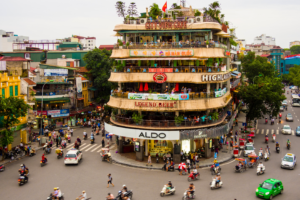
Guide to transportation in Vietnam: Strolling around Hoan Kiem Street (Source: Internet)
Once you’ve decided on your primary mode of transportation in Vietnam, things become much simpler. For group travel, you can easily find bus or car rental services through official websites or third-party booking platforms. If you’re using a motorbike, rental agencies are abundant in most major cities, and many hotels offer motorbike rental services as well. Be sure to check the reviews and the condition of the vehicles to avoid any issues during your trip.
Another helpful tips:
- If you book a car or bus, many local drivers can assist you in planning your route, suggesting key attractions, or advising on the best times to visit specific places. They know the area well and can help create an itinerary that maximizes your time and enjoyment.
- If you’re driving a motorbike, you’ll need to do your own research. Take the time to check out local sights, scenic spots, and key landmarks along the way, ensuring you don’t miss out on any must-see destinations. Planning your route in advance will help you avoid getting lost and make the most of your trip.
For first-time visitors to Vietnam, preparing all this information may feel overwhelming, but it can also be part of the fun and excitement. However, if you’re someone who prefers a hassle-free experience and doesn’t want to deal with the logistics, booking transportation through a tour operator is highly recommended.
A guide to transportation in Vietnam can also help you navigate your options and make informed decisions, but relying on a tour operator can simplify the process even further.
Avoiding Scams
Vietnam is generally safe for tourists, but like any destination, it’s important to be mindful of potential scams. Always confirm the price before using a cyclo (rickshaw) or traditional taxi. Many drivers may not use meters and may try to charge more than necessary.
To avoid this, either agree on a price upfront or use a ride-hailing app, which is more transparent and often cheaper. Avoid accepting rides from unsolicited taxi offers on the street, as these can sometimes lead to inflated fares.
Read more>>> Travel Safe in Vietnam: Crime and Safety Tips for Tourists
Safety Measures
Safety is key when exploring Vietnam, especially when using motorbikes, a common mode of transport. If you plan to ride a motorbike or a scooter, make sure to wear a helmet (it’s required by law in Vietnam, and fines can be issued if not followed). If you’re not comfortable riding, consider hiring a local driver or using ride-hailing services.
For private car bookings, always check reviews beforehand to ensure the reliability of the service. It’s also a good idea to download navigation apps like Google Maps if you plan to travel independently by bike or car.
Packing Essentials
- For long-distance travel: You may need neck pillow, water bottle, snacks, travel-sized hand sanitizer, eadphones, books, portable charger.
- For overnight journeys: You may need eye masks, earplugs, light blanket, small toiletry bag (toothbrush, toothpaste…), medications or personal items
- For day trips: You may need sunscreen, sunglasses, portable charger, comfortable clothing a small backpack or tote for your essentials.
FAQs About Transportation in Vietnam
Is it worth taking the train in Vietnam?
Yes, taking the train in Vietnam is worth it if you appreciate scenic views and a relaxed pace. Trains offer a great way to enjoy the country’s landscapes, from lush countryside to coastal vistas, while avoiding the discomfort of winding roads. It’s also a good choice for those prone to motion sickness. Train fares are affordable, and for those seeking luxury, premium services like the Vietage Train provide top-notch amenities, such as comfortable cabins and gourmet meals.
What is the safest way to get around Vietnam for first-time visitors?
The transportation options mentioned above are all very safe, and each one may have its own advantages and limitations depending on your preferences and needs.
Therefore, the safest transportation in Vietnam is the one you’ve booked in advance after researching and checking reviews, or through a trusted tour operator. Local operators, with their deep knowledge of transportation options, can guide you to the best choices that suit your needs. They understand the local landscape and offer valuable insights to ensure you’re traveling in comfort and safety.
For a smooth and reliable experience, you can always reach out to Prime Travel. We provide expert guidance and high-quality transportation to ensure the safest and most comfortable journey during your time in Vietnam.
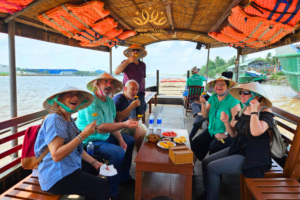
Guide to transportation in Vietnam: Boating on the Mekong River (Source: Prime Travel)
Are ride-hailing apps reliable in Vietnam?
Ride-hailing apps like Grab, Be and Xanh SM are very reliable in Vietnam, especially in major cities like Hanoi, Ho Chi Minh City, and Da Nang. As part of a comprehensive guide to transportation in Vietnam, these apps offer transparent pricing, allowing you to see the fare before confirming your ride. They also provide real-time tracking, so you can monitor your driver’s location and estimated arrival time.
